
- GSTC Mission & Impacts
- GSTC History
- Market Access Program
- GSTC Board of Directors
- Assurance Panel
- Working Groups
- GSTC Sponsors
- GSTC Members
- Recruitment
- Contact GSTC
- GSTC For the Press
- Criteria Development, Feedback & Revisions
- Sustainable Tourism Glossary
- SDGs and GSTC Criteria
- GSTC Industry Criteria
- GSTC Destination Criteria
- GSTC MICE Criteria
- Criteria Translations
- GSTC-Recognized Standards for Hotels
- GSTC-Recognized Standards for Tour Operators
- GSTC-Recognized Standards for Destinations
- Recognition of Standards (for Standard Owners)
- GSTC-Committed
- Certification for Hotels
- Certification for Tour Operator
- Certification for Destination
- Accreditation for Certification Bodies
- Accredited Certification Bodies
- Stakeholder Consultations
- What is Certification? Accreditation? Recognition?
- Sustainable Tourism Training Program (STTP)
- Upcoming Courses
- Professional Certificate in Sustainable Tourism
- Professional Certificate in Sustainable Business Travel
- GSTC Trainers and Partners
- FAQs: GSTC Training Program
- Organization Membership Application
- Destination Membership Application
- Membership Policy
- Membership Categories & Fees
- Membership Payment Options
- Webinars for GSTC Members
- Members Log In
- Upcoming Webinars
- GSTC2024 Singapore, Nov 13-16
- Upcoming Conferences
- Past Conferences
- Destination Stewardship Report

Vanuatu Tourism Gets a Reboot
Destination stewardship report – autumn 2021 (volume 2, issue 2).
This post is from the Destination Stewardship Report ( Autumn 2021, Volume 2, Issue 2 ), an e-quarterly publication that provides practical information and insights useful to anyone whose work or interests involve improving destination stewardship in a post-pandemic world.
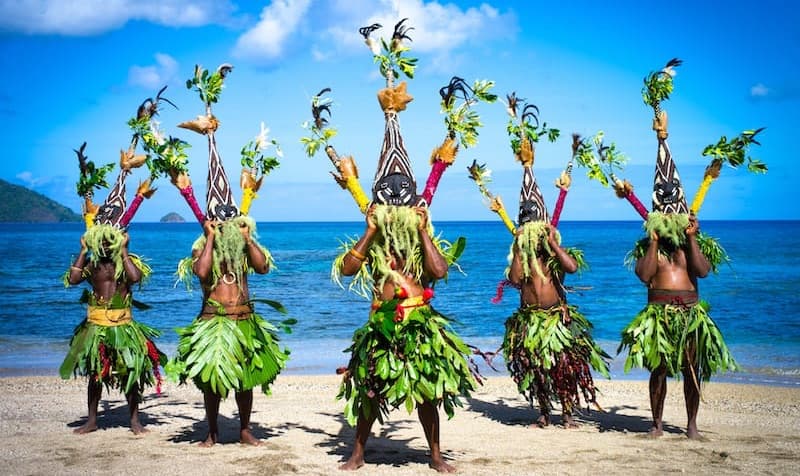
Naluandance, Malekula culture. All photos Courtesy of the Vanuatu Department of Tourism
The pandemic has caused massive disruption to the tourism industry around the world. But it has also created an opportunity for destinations to reboot the sector to move forward in a more thoughtful and sustainable way. Here, Geoff Hyde shares how Vanuatu is doing just that.
Living its Ni-Vanuatu Values: Vanuatu Plans for Resilience, Agritourism, and Cruise Reform
“I rely on volcano tours for my livelihood but I also want to protect my family and community from getting sick from Covid,” said a local guide at a recent tourism workshop in Ambrym, Vanuatu. Indeed, Vanuatu’s Department of Tourism (DoT), in conjunction with public health officials, has been conducting workshops around the country to deliver the twin messages of business survival through financial grants while following health protocols, including vaccinations, to provide safe business and community environments when borders reopen.
Located in the South Pacific, Vanuatu has a strong and authentic Melanesian culture and an abundance of natural assets within its 83 islands. Closure of international borders has plunged the economy into a serious socio-economic crisis. Like most small island states, Vanuatu has been heavily dependent on its tourism sector.
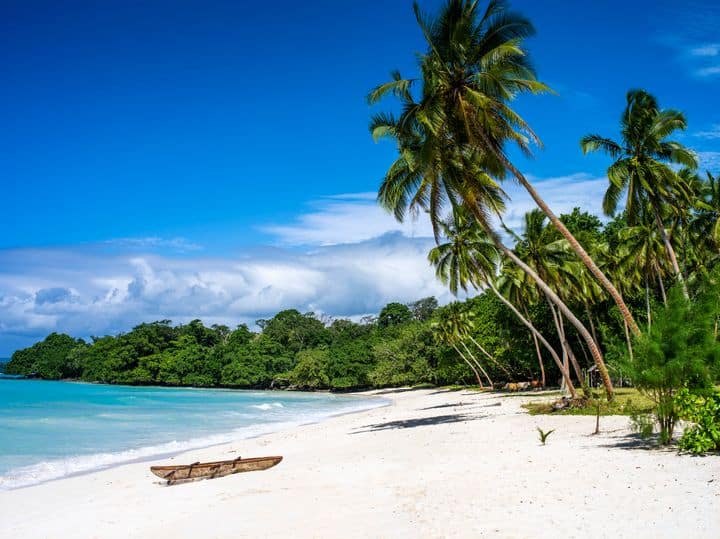
Gaua Beach, Torba Province.
Economic Reliance on Tourism
According to World Bank data , from 2016-18, Vanuatu had the eighth highest proportion of tourism receipts and the seventh-highest direct contribution of tourism to GDP. More recent pre-Covid 2019 tourism statistics from the World Travel and Tourism Council, show the direct and indirect contributions of tourism in Vanuatu accounted for 48% of GDP (Vt 46.8 billion). This data, combined with over 135,000 cruise ship arrivals in 2019 add another Vt 2.1 billion to Vanuatu’s economy (DoT Sustainable Cruise Tourism Plan, 2020 .) All totalled, these statistics reveal a high level of reliance on the tourism sector.
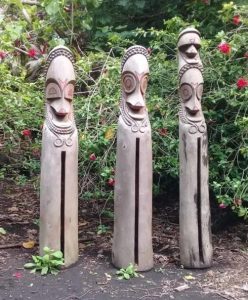
Tam-Tams in the Nasara sacred Rom Dance Ground.
Such a dependency was recognised by the Vanuatu DoT well before the pandemic hit. From 2016, the DoT had been planning for and implementing a more sustainable and diversified approach to tourism development. In 2018, Vanuatu DoT joined the Global Sustainable Tourism Council (GSTC) as a destination member and signed an MOU to support Vanuatu’s tourism industry on the progress it had made in the path to becoming a sustainable tourism destination. Funded through NZAid, the Vanuatu Strategic Tourism Action Plan produced the Vanuatu Sustainable Tourism Policy 2019-2030 , a key initial project informed by nationwide stakeholder consultation. A vital piece of this policy included its Vision, which states, “To protect and celebrate Vanuatu’s unique environment, culture, kastom [traditional, authentic culture], and people through sustainable and responsible tourism” with its goals and objectives based on a set of these shared values:
“Tourism in Vanuatu embraces the traditional and formal economies; it provides sustainable growth by strengthening national and community resilience with the ultimate goal of delivering equitable economic, social, cultural and environmental benefits for Vanuatu and its people.”
Vanuatu’s Crisis Response in Action
In response to the international border closure, the DoT quickly established the Tourism Crisis Response and Recovery Advisory Committee comprising government representatives, including the Director of Public Health, and private sector stakeholders. Tourism sector policy advice and information was then fed into the National Disaster Management Committee .
This resulted in two planning documents with action plans:
- The Immediate Safety, Response and Economic Recovery Plan, May to December 2020 for short term responses delivered under the five pillars of health, access, product, marketing, and communications; and
- Wellbeing: through High Value, Low Impact Tourism
- Resilience: through Niche Tourism Product Development
- Diversification: through Agritourism
- Sustainability: through Certification, Investment and Ni-Vanuatu Entrepreneurship
Despite the setbacks from the pandemic, the DoT has been further encouraged and inspired to implement this sustainable tourism strategy and program as part of the recovery process. This will help diversify the product and create resilience within the tourism sector. Under the VSTS, DoT and its partners are now implementing sustainable tourism programs, utilising one or more of the above themes.
The programs are:
Tourism Business Support Program (TBSP) – launched in March 2021 and managed by DoT through a representative Steering Committee. The TBSP provides financial support and technical assistance for eligible tourism businesses to survive the pandemic’s impacts and have them ready to receive tourists when borders reopen. The eligibility criteria encourage tourism businesses to follow the principles of sustainable and responsible tourism by signing a code of conduct promoting product diversification and increasing local benefits. Financial assistance is available in these categories:
- Tourism Business Survival Grants : for costs associated with cleaning, maintenance, gardening, security, safety, and utility bills.
- Renewable Energy Subsidy Scheme : for equipment and appliance purchasing through the National Green Energy Fund.
- Agritourism Support Program : assistance for selected projects that have integrated the tourism and agriculture sectors into their products. For example, the famed Jungle Zipline attraction is now diversifying into cacao and macadamia nut production to supply local chocolate manufacturers and develop tours when borders reopen.
Safe Business Operations (SBO) Training Program – commenced in October 2020, SBO is mandatory industry training across all sectors to ensure workplace compliance with the health and safety protocols for Covid-19. To date, training workshops and awareness sessions have been delivered to over 2,000 participants in 1,323 businesses across all provinces. SBO is managed by DoT in partnership with the Department of Public Health, the Australia Pacific Training Coalition, the Vanuatu Chamber of Commerce and Industry, World Vision Vanuatu, Vanuatu Institute of Technology, and Vanuatu Skills Partnership.
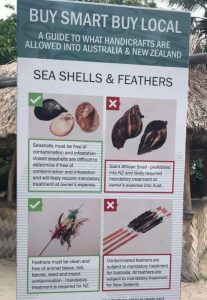
Sign at a handicraft market.
Agritourism Support Program – encourages diversification and resilience by integrating agriculture and tourism products. It attempts to create a point of difference with Vanuatu’s local cuisine through the ‘Traditional Cuisine Revival Program’ and the ‘Slow Food Educational Program.’ The latter aims to increase the use of local, sustainable, and organic produce within the tourism industry and raise the nutritional quality of food served to tourists. The DoT is implementing a business mentoring program for 27 local businesses who have now formed the Vanuatu Agritourism Association. This includes business planning, management and digital marketing, as well as presentations on the SBO and TBSP.
Cruise Tourism Product Development Program – has been implementing the Vanuatu Sustainable Cruise Tourism Plan adopted in March 2020. The Government of Vanuatu is adopting a stronger presence in the management and control of the cruise tourism segment under ‘high value–low impact’ sustainable tourism principles. The DoT has also recently commissioned independent local consultants to undertake a feasibility study for an Expedition ship to be based in Vanuatu to develop a ‘fly-cruise’ product more conducive to sustainable tourism principles and increased Ni-Vanuatu benefits. A more representative management committee, chaired by DoT, has been established to implement a Memorandum of Agreement (MOA) with the two main cruise companies, Carnival and Royal Caribbean. This MOA was independently reviewed by Sustainable Seas Ltd (UK) and includes references to the GSTC Destination Criteria.
About Geoff Hyde
Mr. Geoff Hyde M.Sc. (Tourism Planning/Development Economics), B.A. (Leisure Planning) is the Managing Director and Principal Consultant of Sustainable Tourism International Ltd . (STIL), a tourism consultancy company dedicated to the principles of sustainable tourism as a tool for socio-economic development. He has spent 30 years as a Tourism Sector Adviser and the last five years as the Technical Adviser to the Vanuatu Department of Tourism.
Share This Story, Choose Your Platform!
Related posts.
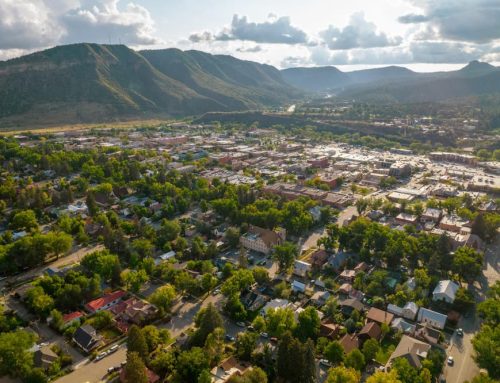
Durango: Destination Stewardship in Action
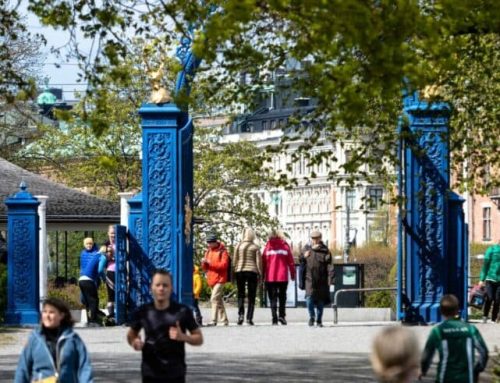
Djurgården Shows How To Collaborate
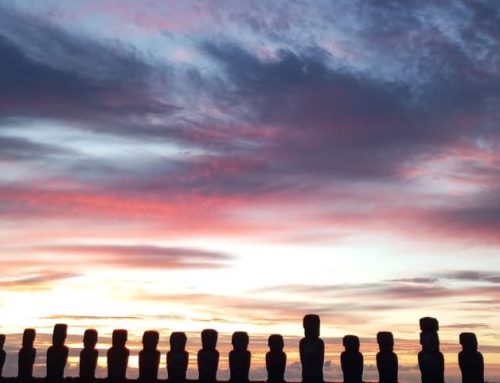
Rapa Nui: Memories of the Future

- Industry News
Made In Vanuatu

Mahitahi Handikraf Senta on the sea front is accepting vendors to fill 53 stalls in the newly built cool, breeze-filled, open thatch-roofed house that will open on November 29.. The criterion for all vendors is to strive to eventually sell only ‘Made in Vanuatu’ products in the new handicraft house. National Handicraft Development Coordinator, Ian Baniuri, from the Department of Industry explains, “It is the long term objective of Mahitahi Handikraf Senta that we will have one central shop or warehouse here in Port Vila where handicraft products from the Provinces are kept in stock for vendors to tap into to sustain their individual supplies. “Port Vila Municipality is partnering in the project and the idea is for the network to connect all the provincial handicraft associations with a long term vision to sell only ‘Made in Vanuatu’ products because our visitors want to buy souvenirs from Vanuatu made in Vanuatu.” The Coordinator explains that there is a National Handicraft Industry Working Group which advises the Department of Industry on handicraft matters. It is made up of Vanuatu Intellectual Property Right, Vanuatu Cultural Centre and other relevant sectors along with donor partners including TVET. “The Group is aware that while we encourage the promotion of our cultural products, we must also consider those specific products which have special significance in the islands where they come from”, he says. Regarding the choices of handicraft items that are promoted for sale, the Coordinator assures the public that all that is taken into consideration by the Group to make sure that what which goes on sale does not risk undermining the cultural significance of the product. He says Torba Province and Malampa Province with TVET partnership have connected with the Department of Industry through their provincial handicraft associations. Regarding imported fabrics, Australian Volunteer Sarah Ahlin who has been asked to help set up the market says vendors are allowed to buy imported fabrics but the designs and styles of products produced have to be from Vanuatu. The volunteer had to leave her project at Saratamata in Penama Province where she worked with the communities to start a handicraft association. When the Manaro Volcano started erupting last month, she moved to Port Vila. She was asked by the Department to help with setting up the stalls. (Source: Vanuatu Daily Post 22 November 2017)
Related posts

Port Denarau Marina Gold Sponsor for inaugural South Pacific Superyacht Rendezvous

South Pacific Tourism Exchange 2025 Dates Announced

Yap Hosting the Pacific’s Premier Dive Photography Events

Tourism in Vanuatu
Development of the tourism sector in vanuatu from 1995 to 2020.

Revenues from tourism

All data for Vanuatu in detail

Academia.edu no longer supports Internet Explorer.
To browse Academia.edu and the wider internet faster and more securely, please take a few seconds to upgrade your browser .
Enter the email address you signed up with and we'll email you a reset link.
- We're Hiring!
- Help Center

An Industry in Crisis: How Vanuatu's Tourism Sector Is Seeking Economic Recovery

2021, COVID in the Islands: A Comparative Perspective on the Caribbean and the Pacific
This chapter recounts and examines the events triggered by the COVID-19 pandemic that produced a steep decline in Vanuatu's tourism industry, the key economic sector during the preceding three decades. This necessitated a rapid policy shift by the Vanuatu Government towards COVID-safe business readiness and a programmatic response to build domestic tourism to revive Vanuatu’s tourism industry during the pandemic. This chapter focuses on Vanuatu’s experience in terms of impacts to tourism businesses, a new domestic tourism campaign and public-private policy shifts to support the resilience of an industry in crisis. It presents three cases that illustrate the response and recovery efforts at the business, sector and policy levels.
Related Papers
Maximiliano E. Korstanje
The specialized literature in disaster studies emphasizes the problems of applied research to forecast exactly the geographical zone or city where the disaster will take a hit. The term disaster appeals precisely to the lack of coherence in responses to outstanding, if not disturbing, events that impact notably society. For this reason, disaster management adopted the figure of resilience and adaptation to deal with post-disaster (pandemic) scenarios. Over the recent years, some voices have alerted on the importance of resilience in the tourism industry. The global pandemic that originated in Wuhan (China) rapidly disseminated throughout the world, paralyzing not only the tourism industry but also the global trade. The COVID-19 obliges us to rethink tourism in a feudalized (atomized) world without tourists. The current travel behavior, as well as the geographical borders, are being reformulated according to a post-pandemic situation. Beyond the material losses and lives, the COVID-19 seems to be a foundational event that redrawn the global geographies. This book chapter deals with the opportunities and challenges of tourism in Argentina just after the COVID-19. We look to answer the question: is post-disaster tourism literature an efficient instrument to put the activity back on its feet again?
MGES Journals
Purpose of the study: COVID-19 pandemic has severely hit the global economy. It has also had a huge impact on the tourism industry. The purpose of the study is to identify the possible initiatives to be taken to revive the tourism industry during or after the COVID-19 era. Methodology: A qualitative analysis of secondary data has been applied. NVivo 12 has been used for organizing, analyzing, and visualizing the data. Main Findings: It is found that government will have to play the most prominent role in the revival of the tourism sector through financial stimulus packages and subsidies. The use of marketing activities, promotional tools, and social media platforms will also aid in the recovery process. Initially, tourism activities can be restarted at domestic levels and in travel bubbles, motivating international tourists. Most importantly, maintaining hygiene and maintaining social distance will be the main tool to revive the tourism industry. Applications of this study: The findings of this study will enable the decision-makers of the hospitality and tourism industry to make a strategic recovery plan Covid-19 stricken tourism economy. The originality of this study: Although most of the industries are slowly turning around during the pandemic, the tourism industry is still struggling to survive. This study proposes several possible recovery plans in light of past epidemic experiences.
Pacific Dynamics
Regina Scheyvens
As with small islands around the globe, many of the island states of the South Pacific are heavily dependent on tourism revenue. This article examines how tourism development and its disturbance by Covid-19 has influenced socio-cultural and economic changes among Indigenous communities in Vanuatu, Solomon Islands, Samoa, Cook Islands, and Fiji. In particular, it demonstrates how the cessation of international tourism in established destination communities has created shifts in the way people live and their livelihood approaches which have moved towards a revival of customary practices. This study was led by Massey University researchers through partnerships with research associates (RAs) based in-country: an online survey and on-site interviews by RAs, along with Zoom interviews by the authors, provided primary data. The paper argues that although Covid-19 has had difficult financial consequences, it has also motivated innovative, culturallybased responses that allow people to adapt effectively to the loss in income associated with border closures. Such changes point to valuable lessons that could inform the management of more resilient tourism in the Pacific.
Journal of Management and Tourism Research
R.S.S.W Arachchi
The COVID-19 pandemic started to attack Sri Lanka in the middle part of the tourism season. During this period a larger number of tourists were enjoying in Sri Lanka while some other tourists were already purchased their holidays. The effect of COVID 19 global pandemic to the tourism industry caused the complete shutdown of tourism not only Sri Lanka, but also in the global context. Top tourist generating markets of Sri Lanka are China, India and UK and these countries are highly affected by this pandemic. The main objective of this review paper is to identify the impact of COVID 19 pandemic on the tourism and hospitality industry employees in Sri Lanka and second, to identify the future challenges faced by the employees of the tourism industry in Sri Lanka. The study was carried out using qualitative methodology with the qualitative data collection techniques. The personal interviews were carried out with the public and private sector officers to get their opinions and suggestions such as Sri Lanka Tourism Development Authority, Sri Lankan Airlines, Sri Lanka Hotel Association, Sri Lanka Inbound travel operators, Sri Lanka Institute of National Tourist guide lecturers. The findings revealed that the industry is badly affected and presently around 12000 tourists are blocked in the country. There are more than 400,000 direct and indirect tourism and hospitality employees in the industry lost their jobs or income sources. All the potential income sources of the country have been blocked and therefore the local community has faced a severe financial crisis. It will not be easy to retain the employees in the tourism and hospitality industry since they expect the job security. Thus, it is essential to go for resilience strategies immediately like such as giving governments support for the industry, conduct programmes to keep positive mind-set of tourism employees to remain within the industry during this hardship, empowering employees effectively. In this critical situation, the industry expect the active mediation of government to facilitate them to face this devastating situation with favourable concessions, relief packages, reduction of tax burden, favourable policies and strategies to rebuild the industry, Tourism Employees Relief Package (TERP) etc. However, it will not be easy in short run in the pandemic affected economies and societies. Therefore, it needs to have effective resilience strategies first, to retain the employees with the industry and next to rebuild the ruined industry
University of Bergamo
Federica Burini
This collection of papers has been written by the international team of scholars teaching at the Master Course in Planning and Management of Tourism Systems of the University of Bergamo, while the Covid-19 emergency was spreading in all parts of the World and especially in the territory of Bergamo. The main aim of the work is to face the topic of Tourism in the case of exogenous shocks, like the Covid-19 pandemic, reflecting on their impacts on territories, communities and heritage both during and after the crisis. The papers adopt different disciplinary approaches and methods, trying to give a multi-focused gaze to the complexity of a global phenomenon and to possible forms of recovery. This collection is addressed to students and researchers studying in the tourism sector, who are in search of answers in this time of change and crisis. We believe that after reading this volume they won't have all the answers to their dilemmas, but they will reflect about them, they will receive proposals for specific approaches, methodologies, sources, references, examples, useful for the future of their own research.
Journal of Indonesian Social Sciences and Humanities
ayu nova Lissandhi
The COVID-19 pandemic has ravaged the global tourism industry, leaving millions of people unemployed without certainty when tourism bounces back. Small Island Developing States (SIDS) are amongst the worst hit by the novel coronavirus. The unprecedented crisis has severely aggravated the SIDS economic growth due to relying on foreign tourists heavily. In the absence of international tourism, small island residents have been grappling with alternative income sources. Despite its notorious impacts, many scholars look at this global pandemic as a discernible opportunity to reverse mass tourism in the SIDS. Therefore, this paper aims to elaborate on the current condition of small islands communities amid COVID-19, their coping strategies, and their reflection of the future tourism industry in the SIDS. Furthermore, this paper also aims to discuss a prevailing policy to contain health emergency and economic collapse in the SIDS. Based on the critical literature review, many SIDS were alr...
Srilal Miththapala
The tourism industry was one of the World’s largest and fastest growing industries just 9 months ago. Today amidst the throes of the CoVid crisis, it is all but devastated and gasping for breath. As the world slowly comes to terms with the deadly virus and the ‘new norm’ emerges, several industries are slowly recovering. However it will be a long uphill battle for tourism to fully recover from the crisis. This monograph attempts to understand why The tourism industry is so badly hit and why it will take long to recover.
Resilience and Economic Intelligence Through Digitalization and Big Data Analytics
IULIANA POP
The tourism industry is often vulnerable to countless risks and global threats. The COVID-19 pandemic not only ground the industry into an unparalleled halt but also has interrogated the future of the activity. This chapter critically discusses the application of resilient to make more sustainable destinations. We hold the thesis that resilience opens the doors to a paradoxical situation. On the one hand, it accelerates the recovery timeframe just after a disaster takes room. On another, it commoditizes disasters to be consumed by a global audience.
International Journal of Applied Management Theory and Research
Vikramaditya Kumar Taneja
The study compares the impacts of Covid-19 to past disease outbreaks, disruptive events, and examines the current effects of the pandemic in general and on the tourism industry in particular. It aims to discuss the impact on demand and supply of the tourism industry, examines the possible recovery of tourism industry, and opportunities to transform practices, norms, and procedures. It discusses about the opportunities for new firms to enter, opportunities for current firms, and strategies to combat the pandemic. A qualitative and a conceptual analysis of the literature on past disruptive events, effects of Covid-19 on tourism industry, and the possible recovery are performed. It predicts that the recovery of tourism industry will be slow. It suggests the roles to be played by various agencies, the need for changing products and experiences, importance of research, opportunities for market entry, and for making structural changes to the industry, and policy implications.
RELATED PAPERS
出售uc毕业证书 加拿大卡尔加里大学毕业证学历学位证书原版一模一样
Scientific Reports
Taiwo Onifade
Brazilian Journal of Cardiovascular Surgery
Ahmet Elibol
Chemistry of Natural Compounds
Journal of Low Temperature Physics
Jean-Paul Jay-Gerin
Public Management Review
Helen Sullivan
simroz khan
Cristina Duboscq
International Journal of Behavioral Medicine
Frank Perna
Nature Communications
Eñaut Izagirre Estibaritz
Francimary Nascimento
The Journal of Applied Laboratory Medicine
Eric Nilles
Stephen D Beck
Rabia Ekti Genç
Orphanet Journal of Rare Diseases
BILAL AHMAD RAHIMI
Drugs and Alcohol Today
Camille Alexis-Garsee
Folia Medica Indonesiana
Olusola Joseph Omotoye
RELATED TOPICS
- We're Hiring!
- Help Center
- Find new research papers in:
- Health Sciences
- Earth Sciences
- Cognitive Science
- Mathematics
- Computer Science
- Academia ©2024

Oils / Chocolate / Perfumes and other products Origin of complete product is Vanuatu or good substantially transformed in Vanuatu
Vanuatu Made includes four official logos that can be individually applied to various products. To know which logo is right for your product depends on what category it qualifies for.
Local Agriculture / Farming Fishing / Hunting
Goods assembled in Vanuatu locally designed / locally enhanced items
Locally made handicrafts Weaving / Painting / Sewing Carving / Jewellery / Pottery Print Making

ChatGPT Assistant
Vanuatu Made Assistant
An Industry in Crisis: How Vanuatu’s Tourism Sector Is Seeking Economic Recovery
- First Online: 30 October 2021
Cite this chapter

- Anna Naupa 3 ,
- Sarah Mecartney 4 ,
- Liz Pechan 5 &
- Nick Howlett 6
468 Accesses
Although Vanuatu experienced no domestic COVID-19 cases in 2020, preventive border closures resulted in the sudden downturn of Vanuatu’s tourism industry, and the closure of many tourism-oriented businesses. Employment experienced a parallel downturn, in both the formal and informal sectors, despite creative efforts at gaining employment. This necessitated a rapid policy shift by the Government directed towards domestic tourism with some limited success. Longer term redevelopment of tourism focused on COVID-safe business readiness and an emergent theme of greater public-private coalition-building to accelerate national economic recovery efforts, including through a reimagining of the industry to cope with the ‘new normal’.
This is a preview of subscription content, log in via an institution to check access.
Access this chapter
- Available as PDF
- Read on any device
- Instant download
- Own it forever
- Available as EPUB and PDF
- Compact, lightweight edition
- Dispatched in 3 to 5 business days
- Free shipping worldwide - see info
- Durable hardcover edition
Tax calculation will be finalised at checkout
Purchases are for personal use only
Institutional subscriptions
Similar content being viewed by others

Tourism Development and Resilience in Ukraine: Challenges and Enhancing Competitiveness

Conclusion: Practical and Policy Perspectives in Reshaping the Tourism and Hospitality Industry Post-COVID-19 Industry

Tourism and COVID-19: Socio-economic Impacts of COVID-19 on the Tourism Industry in Bulgaria
Asian Development Bank. (2019). Asian Development Bank Outlook. In Strengthening Disaster Resilience . Asian Development Bank.
Google Scholar
Cheer, J., & Lew, A. (2017). Understanding Tourism Resilience: Adapting to Social, Political, and Economic Change. In J. Cheer & A. Lew (Eds.), Tourism, Resilience, and Sustainability: Adapting to Social, Political and Economic Change (pp. 3–17). Routledge.
Chapter Google Scholar
Dornan, M., & Cain, T. (2019). Vanuatu and Cyclone Pam: An Update on Fiscal, Economic, and Development Impacts, Pacific Economic Monitor, May, 30–35.
Government of Vanuatu. (2019). Half-Year Economic and Fiscal Update of 2019 . Ministry of Finance and Economic Management. https://doft.gov.vu/images/2019/Economic_And_Fiscal_Report/HYEFR_English_2019.pdf . Accessed 22 Nov 2020.
Government of Vanuatu. (2020a, April). National Tourism Business Impacts Survey: TC Harold and COVID-19 Pandemic . Department of Tourism and Vanuatu Tourism Office.
Government of Vanuatu. (2020b). Yumi Evriwan Tugeta: Vanuatu Recovery Strategy 2020–2023 .
Graue, C. (2020, July 12). Vanuatu Feeling the Pinch as Coronavirus Pandemic Keeps Tourists Away , ABC Pacific Beat .
Orchiston, C., Prayag, G., & Brown, C. (2015). Organisational Resilience in the Tourism Sector. Annals of Tourism Research, 56 , 128–163.
Vanuatu Chamber of Commerce and Industry. (2020). Vanuatu Economic Outlook from a Private Sector Perspective . https://vcci.vu/vanuatu-economic-outlook-report-from-a-private-sectors-perspective/
Vanuatu Tourism Office. (2019). Towards 300,000: Sustainability, Partnership, Benefit for all: Vanuatu Tourism Market Development Plan 2030 .
Vanuatu Tourism Office. (2020). Vanuatu International Visitor Survey 2019. In Collaboration with the Auckland University of Technology, NZ MFAT, and the NZ Tourism Research Institute.
Watt, G., & Brenner, H. (2020). Cruise Tourism in Vanuatu: Impacts and Issues . The Council for Australasian Tourism and Hospitality Education 2020 Conference, 344–349.
Download references
Author information
Authors and affiliations.
Australia-Pacific Technical College, Port Vila, Vanuatu
Pacific Community (SPC), Nouméa, New Caledonia
Sarah Mecartney
The Havannah, Port Vila, Vanuatu
Vanuatu Tourism Office, Port Vila, Vanuatu
Nick Howlett
You can also search for this author in PubMed Google Scholar
Editor information
Editors and affiliations.
University of the West Indies, Kingston, Jamaica
Yonique Campbell
School of Geosciences, University of Sydney, Sydney, NSW, Australia
John Connell
Rights and permissions
Reprints and permissions
Copyright information
© 2021 The Author(s), under exclusive license to Springer Nature Singapore Pte Ltd.

About this chapter
Naupa, A., Mecartney, S., Pechan, L., Howlett, N. (2021). An Industry in Crisis: How Vanuatu’s Tourism Sector Is Seeking Economic Recovery. In: Campbell, Y., Connell, J. (eds) COVID in the Islands: A comparative perspective on the Caribbean and the Pacific. Palgrave Macmillan, Singapore. https://doi.org/10.1007/978-981-16-5285-1_13
Download citation
DOI : https://doi.org/10.1007/978-981-16-5285-1_13
Published : 30 October 2021
Publisher Name : Palgrave Macmillan, Singapore
Print ISBN : 978-981-16-5284-4
Online ISBN : 978-981-16-5285-1
eBook Packages : Social Sciences Social Sciences (R0)
Share this chapter
Anyone you share the following link with will be able to read this content:
Sorry, a shareable link is not currently available for this article.
Provided by the Springer Nature SharedIt content-sharing initiative
- Publish with us
Policies and ethics
- Find a journal
- Track your research
- Topics ›
- Hotel industry in Europe ›
Where Domestic Tourism Matters Most to Local Accommodation Businesses
Sponsored post by booking.com.
In the 2024 edition of the European Accommodation Barometer , the study has revealed that although 76% of European hoteliers feel that Domestic visitors important or very important to the success of their business, this importance varies from country to country. For larger countries like Germany and France, domestic visitors are seen as important to business success by 92% and 88% of hoteliers respectively. On the other end of the spectrum, southern European countries such as Portugal and Spain seem to place a stronger emphasis on international tourism when it comes to identifying their most profitable visitor cohort.
Description
This infographic shows the share of European hoteliers who believe that domestic visitors are (very) important to the success of their business.
Can I integrate infographics into my blog or website?
Yes, Statista allows the easy integration of many infographics on other websites. Simply copy the HTML code that is shown for the relevant statistic in order to integrate it. Our standard is 660 pixels, but you can customize how the statistic is displayed to suit your site by setting the width and the display size. Please note that the code must be integrated into the HTML code (not only the text) for WordPress pages and other CMS sites.

Infographic Newsletter
Statista offers daily infographics about trending topics, covering: Economy & Finance , Politics & Society , Tech & Media , Health & Environment , Consumer , Sports and many more.
Related Infographics
Sponsored post by booking.com, top issues governments should prioritize to support eu tourism, chinese tourists: the big spenders of the coming decade, size matters: chain hotels in europe have an economic advantage, where hoteliers feel most threatened by climate change, sustainable tourism: collective responsibility of providers, travelers, and goverenments, domestic robots, everyday robots, a widening gap: smes struggling to keep up with large enterprises, china trade, china's most important export partners, european hoteliers’ biggest opportunities for 2024, china smartphones, apple's china business stays volatile as market calms, 5% of americans are digital nomads, are americans moving from blue to red states.
- Who may use the "Chart of the Day"? The Statista "Chart of the Day", made available under the Creative Commons License CC BY-ND 3.0, may be used and displayed without charge by all commercial and non-commercial websites. Use is, however, only permitted with proper attribution to Statista. When publishing one of these graphics, please include a backlink to the respective infographic URL. More Information
- Which topics are covered by the "Chart of the Day"? The Statista "Chart of the Day" currently focuses on two sectors: "Media and Technology", updated daily and featuring the latest statistics from the media, internet, telecommunications and consumer electronics industries; and "Economy and Society", which current data from the United States and around the world relating to economic and political issues as well as sports and entertainment.
- Does Statista also create infographics in a customized design? For individual content and infographics in your Corporate Design, please visit our agency website www.statista.design
Any more questions?
Get in touch with us quickly and easily. we are happy to help.
Feel free to contact us anytime using our contact form or visit our FAQ page .
Statista Content & Design
Need infographics, animated videos, presentations, data research or social media charts?
More Information
The Statista Infographic Newsletter
Receive a new up-to-date issue every day for free.
- Our infographics team prepares current information in a clear and understandable format
- Relevant facts covering media, economy, e-commerce, and FMCG topics
- Use our newsletter overview to manage the topics that you have subscribed to
The promise of travel in the age of AI
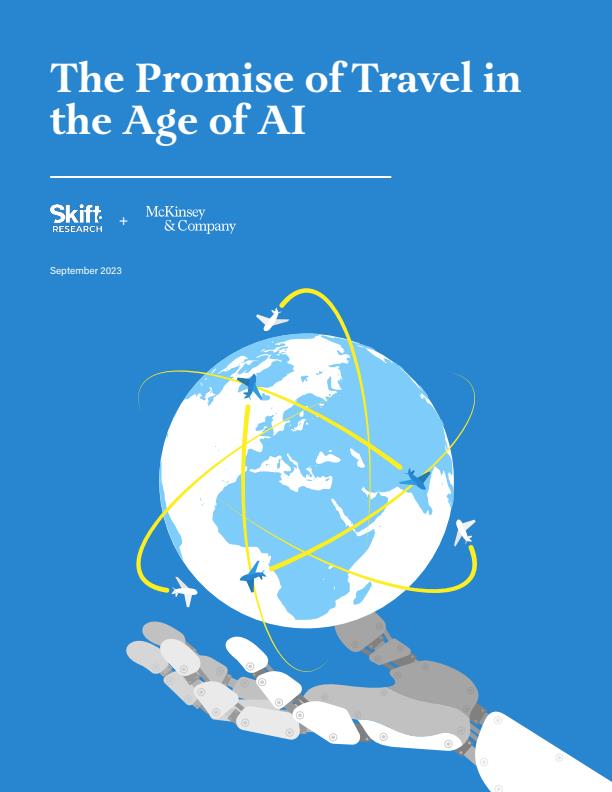
Every generation has its own “golden age” of travel, often defined by the widespread adoption of new technology—from the jet engine of the 1950s that drastically reduced travel times to the dot-com period of the 1990s that allowed customers to build their dream itineraries online. Today, a new era of digitally enabled travel is upon us. Advances in artificial intelligence (AI), including generative AI (gen AI), and machine learning (ML) are equipping the industry to reimagine what it means to plan, book, and experience travel. This surge of innovation sets the stage for travel companies to rethink how they interact with customers, develop products and services, and manage operations.
Advances in technology have also transformed consumers’ expectations. Since 2013, time spent on digital devices has grown by 70 percent, and this trend only accelerated during the COVID-19 pandemic as online interactions increasingly replaced in-person contact. 1 Based on data from U.S. Census Bureau and Statista. See State of travel 2023 , Skift Research, July 21, 2023. However, traditional travel is unique in that it is an inherently human-centric experience. The industry, therefore, has an opportunity—perhaps even a duty—to define what travel will look like in the digital age.
Most travel companies aim to provide exceptional service and deliver the perfect trip. But, instead of ease, excitement, and delight, travel operators too often fall short of meeting baseline expectations of timing and quality. In fact, nearly 80 percent of American travelers experienced at least one travel-related problem in the first half of 2023. 2 Lane Gillespie, “Survey: 77% of travelers plagued by travel problems amid booming season; more than half saw higher prices,” Bankrate, July 10, 2023.
In the 2021 report, Rebooting customer experience to bring back the magic of travel , McKinsey and Skift Research found that leisure travelers were eager to get back to the sky, water, and road—so much so, that they were often willing to overlook customer-service issues and inconveniences. Customer satisfaction ratings at the time were high, even in a period of intense disruption when negative sentiment was on the rise. 3 Rebooting customer experience to bring back the magic of travel , a joint report from McKinsey and Skift Research, September 2021.
Today, that window of acceptance may have passed. Customer expectations are rising, and tolerance is wearing thin. Despite this, people still aspire to travel and, according to McKinsey’s ConsumerWise Sentiment Survey, nearly a third of consumers intend to “splurge” on travel expenses in the next three months. 4 McKinsey ConsumerWise Global Sentiment Survey, August 2023, n=4,000. Through both established and new technologies, companies have the opportunity to keep the aspiration to travel alive by closing the persistent gap between the promise and reality of travel.
While larger companies may have more resources to develop in-house capabilities, a robust ecosystem of service providers makes new technologies accessible to companies of all sizes. According to McKinsey Digital estimates, companies that holistically address digital and analytics opportunities throughout their organizations have the potential to see a 15 to 25 percent earnings improvement.
A new report , The promise of travel in the age of AI , produced by McKinsey and Skift Research offers use cases and success stories that detail how technologies are being used, drawing from interviews with executives at 17 companies across five types of travel business. It explores how companies apply advanced data science to better understand and serve customers, delves into how digital and analytics tools can improve products and services, and examines how new technologies augment workforce capabilities and unlock operational capacity. This article highlights some key findings.

McKinsey Live event: Faces, places, and trends: The state of tourism & hospitality
Thursday, June 13 at 10:30 a.m EDT / 4:30 p.m CET
Know your customers like you know your friends
Over the past two decades, the variety and volume of customer data that travel companies can capture has increased dramatically; new tools and technologies such as AI-powered assistants are only accelerating this trend. However, this data is often difficult to process and does not always paint a full picture of the customer. Companies may turn to third-party sources to complete their understanding—combining and distilling commercial, operational, financial, and behavioral inputs. Robust marketing technologies can then help distinguish the “signal” from the “noise” in the data to better predict customer behavior.
Having gained a clear and comprehensive understanding, companies can create customer segments to guide how they interact with and serve different customers. Depending on the data available and the analytics capabilities at hand, segmentation can range from grouping customers into segments based on a single macro characteristic (e.g., business versus leisure) to individual “segments of one,” known as hyper-segmentation.

Drilling down to segments of one can enable hyper-personalization, which is broadly defined as the ability to uniquely tailor touchpoints to an individual customer’s needs, preferences, and behaviors. At its core, hyper-personalization is not only about increasing conversion rates, but about providing the customer with an end-to-end experience adapted to their specific context. Considering the level of personalization that is becoming the norm in many aspects of daily life, companies are adopting an ongoing test-and-learn approach to ensure their offers and actions resonate with customers’ rising expectations.
Hyper-personalization can also help companies rebuild trust if operations have gone wrong. Personalized communication reassures customers that they are at the forefront of the company’s mind and instills confidence that a thoughtful recovery plan is in place. For example, companies may share real-time status updates in moments of disruption and provide tailored solutions, or even proactive compensation, to ensure customers feel individually taken care of.
Design your products to surprise and delight
Recent advances are pushing the boundaries of what technology can accomplish. Nothing illustrates this better than the meteoric rise of AI platforms like ChatGPT which garnered one million users in only five days. 5 Steve Mollman, “ChatGPT gained 1 million users in under a week. Here’s why the AI chatbot is primed to disrupt search as we know it,” Yahoo News, December 9, 2022. While this pace of adoption may feel unsettling, it provides an impetus for companies to reimagine their product design and delivery using AI and digitization.
Historically, capabilities such as language, creativity, and aesthetic judgment—once considered uniquely human—could not be scaled through technology. AI, particularly gen AI, offers a new way to augment and scale these capabilities with the potential for enormous benefits: according to McKinsey research , generative AI has the potential to unlock between $2 trillion and $4 trillion in annual value across industries. 6 The economic potential of generative AI: The next productivity frontier , McKinsey, June 14, 2023. In the travel context, gen AI could take the form of a digital assistant that interacts with customers throughout the journey. It can provide personalized trip itineraries during discovery and booking, offer tailored recommendations based on preferences and real-time constraints during the trip, and help resolve unexpected disruptions.
However, AI is only part of the answer. Established digital technology also helps companies deliver on commitments made to customers. Many of these digital assets and tools rely on common systems and capabilities, making them widely attainable—freeing up staff to provide better face-to-face services and build relationships through the human touch. Several such applications can boost guest satisfaction and reduce points of friction in hotels, including guest apps, digital check-ins, digital room keys, and in-room tech. The magnitude of these individual tools is amplified when seamlessly integrated together, making it easier for customers to use digital applications throughout their hotel stay.
Empower your workforce to follow through on promises made
An engaged and productive workforce enables the delivery of experiences and products that satisfy customers. However, the travel industry faces structural labor hurdles and high turnover which makes attracting, training, and retaining top talent challenging. Fortunately, the industry can enhance and scale the capacity of its existing workforce by equipping the frontline with the right tools at the right time. This can free up employees to focus on the things they enjoy most and that make the travel industry tick: quality personal interactions with customers, in essence, the human touch.
Two promising opportunities to improve workforce and operational performance through technology stand out across the travel industry: augmenting frontline capacity and upskilling talent.
In the travel industry today, complex decisions still rely on human expertise and outdated technology such as greenscreen or rudimentary interfaces. This leads to a best-guess approach, the risk of negative outcomes, and a steep learning curve. Travel companies are developing new tools for the frontline to process complex inputs and help guide “day-of” decision making. For example, advanced simulation models such as digital twins allow companies to conduct rapid “what-if” analyses and provide real-time guidance to the frontline.
According to McKinsey research , new technology, including gen AI, is also shortening training times for new hires while rapidly upskilling the existing workforce. For instance, virtual and augmented reality are used to simulate real-life scenarios to prepare frontline employees to hit the ground running, and gen-AI-enabled "teaching assistants” provide personalized coaching based on individual performance. 7 “ The organization of the future: Enabled by gen AI, driven by people ,” McKinsey, September 19, 2023.
Travel is ripe for innovation
Checklist for the age of ai.
Some travel companies are already successfully deploying digital technology, AI, and ML to reshape how they interact with customers, develop and deliver products and services, and manage people and operations. They’ve taken the following actions—are you on track?
General considerations
- created a digital wish list—as if the company had infinite time and resources
- prioritized wish list based on potential short- and long-term benefits as well as the company’s strategic vision and available resources
- assessed the skills and talent necessary to execute against the prioritized wish list
- built the right team and identified roadmap to fill remaining gaps
- inventoried existing internal customer data
- determined which data variables drive customer behavior and predict customer buying decisions
- identified relevant third-party data and integrated with internal data to build a complete customer picture
- considered using a robust MarTech stack to continuously learn and evolve with customers
- defined a dynamic segmentation and personalization approach based on customer personas
- adopted test-and-learn mindset to continually implement and refine
- mapped the end-to-end customer journey and identified pain points
- used analytics to determine which pain points impact customers the most
- considered new technology (like AI) to enhance and reimagine the customer journey
- brainstormed improvements to current digital offerings that would minimize pain points (such as more timely communication)
- built a product roadmap based on timing and importance of features
- diagnosed top day-to-day employee pain points
- determined if digital tools can resolve top pain points (for example, automate repetitive tasks)
- provided workforce with real-time visibility into critical areas of daily operations
- used simulation models to plan for multiple future-state scenarios
- built decision-making tools (such as digital twins) to choose optimal solutions for complex problems
- defined opportunities to improve training (using tools such as simulation training, VR, AR) and provide feedback (using smart-AI tool)
We believe this is a moment of optimism for the industry. Between reclaiming its historical share of GDP, benefiting from the ongoing corporate travel recovery, and catering to consumer demand for unique experiences, the stage is set for travel’s accelerated growth. Looking ahead, travel is forecasted to grow at an average of 5.8 percent a year through 2032—more than double the expected growth rate of the overall economy (at 2.7 percent a year). 8 “Travel & Tourism sector expected to create nearly 126 million new jobs within the next decade,” World Travel & Tourism Council, April 21, 2023.
This does not mean that travel companies can simply sit back and reap the benefits. Existing and new technologies provide an avenue for companies to capture their share of the industry’s anticipated growth by resetting how they interact with customers, deliver products and services, and empower their workforce. Fortunately, there are a growing number of ways—build, buy, or partner—to help companies get started. The only wrong move is no move.
Susann Almasi is an associate partner in McKinsey’s Carolinas office, Alex Cosmas is a partner in the New York office, Sam Cowan is a consultant in the Minneapolis office, and Ben Ellencweig is a senior partner in the Stamford office.
The authors wish to thank Skift’s Pranavi Agarwal, Seth Borko, and Wouter Geerts as well as McKinsey’s Marisa Ancona, Danielle Bozarth, Vik Krishnan, Nina Lind, Elena Patel, Alessandra Powell, Jules Seeley, and Nirva Vassa, for their contributions to this article.
Explore a career with us
Related articles.

What every CEO should know about generative AI

Generative AI and the future of work in America

The future of tourism: Bridging the labor gap, enhancing customer experience

For aviation updates, click here for more information.
Vanuatu Souvenir
Entertainment Port Vila Phone: 5918889 Email: This email address is being protected from spambots. You need JavaScript enabled to view it.
- Add to wishlist
Description
Vanuatu Souvenir specialize in Vanuatu gifts and classic souvenirs! With 3 retail stores across Port Vila (Downtown, Central Bay Mall and Central) with a vast selection of Vanuatu gift ideas, it's a sure bet that you will find the perfect souvenirs to take home or send overseas.
We're your one-stop-shop for Vanuatu souvenirs. Give the Gift of Vanuatu today!
Map & Directions
vanuatu souvenir port vila
Located in the heart of Port Vila city next to ANZ Bank.
Subscribe to our Mailing List
- [email protected]
- Mon - Fri 08:00 - 17:00
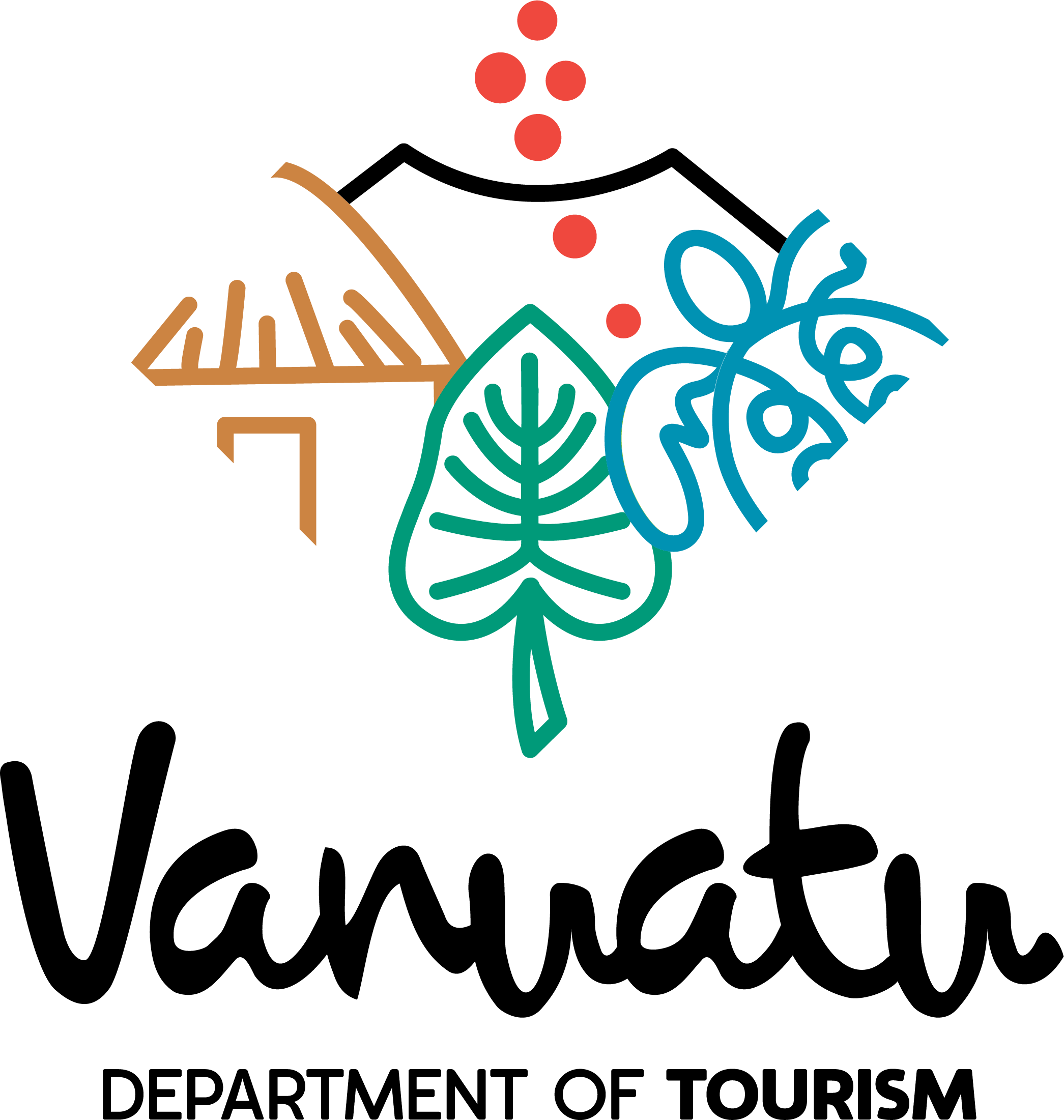
Reports, Plans & Policies
- Relevant Acts
- presentations
Department of Tourism 2021 Business Plan and Annual Work Program
validation meeting presentation document.
Below Is a list of Presentations presented at Emua
Vanuatu International Visitor Surveys
Below is a collection of reports produced using information collected from International Visitor Surveys.
- RTI Compliance
- Departmental Organisation
- Tourism Partnerships
Department News
- COVID-19 Updates
- Recovery Updates
- General Updates
- Trip Reports
Useful Links
- Vanuatu Tourism Office
- Vanuatu Skills Partnership
- Vanuatu National Statistics Office
- About Department of Tourism
- Tourism Projects
- Recovery Plan - Phase 1
- Plans/Strategies
- Niufala Rod Blo Tourism
- Provincial Product Statistics
- Vanuatu Cruise Tourism Strategy
- Expeditions
- Product Development Process
- Iconic Tourism Products
- Accreditation
- Outer Islands
- Tourism Business Support Program
- Safe Business Operations
Cabo Verde Economic Update 2024: Blue Economy: Navigating Towards Sustainable Growth in Cabo Verde

Fishing boats at the fishing pier in São Vicente.
Marco Silva | World Bank Cabo Verde
STORY HIGHLIGHTS
- Despite the challenges posed by the COVID-19 pandemic, Cabo Verde's economy has shown resilience, but has revealed structural vulnerabilities, such as overdependence on tourism and weaknesses in the State Business Sector (SBS).
- With its vast Exclusive Economic Zone, Cabo Verde must prioritize the development of the blue economy, targeting sustainable and resilient activities to boost economic growth and tackle climate challenges.
- The Economic Update 2024 report offers a comprehensive analysis of the state of the Cabo Verdean economy in 2023 and projections for 2024, providing valuable insights for policies aimed at strengthening the country's economy.
Cabo Verde's economy is recovering well from the enormous challenges posed by the COVID-19 pandemic. However, the crisis has highlighted the country's inherent weaknesses, from heavy dependence on tourism to the lack of buffers for economic shocks and the inherent risks in the SBS. The impacts of climate change exacerbate these vulnerabilities.
Against this backdrop, the Economic Update 2024 entitled Blue Economy: The Latent Potential of Fisheries and Aquaculture in Cabo Verde , analyzed the state of the economy in 2023 and made projections for 2024, seeking to assess the short-term economic outlook of the country and offer policy options to strengthen the economy.

Recent Economic Developments
Economic growth slowed to 5.1% in 2023, despite the return of exports, especially in tourism, to pre-pandemic levels. Inflation also fell to 3.7%, driven by the fall in fuel and food prices. Tourism continues to lead growth, but other sectors, such as transportation and public administration, also contribute significantly. However, the country still faces challenges in relation to poverty, with higher levels than before the pandemic.
Fiscal consolidation efforts have proved successful, with the budget deficit reduced to -0.3% of GDP in 2023. However, the continued dependence of State-Owned Enterprises (SOE) on government support poses considerable fiscal risks. Public debt has also fallen to 113.8% of GDP, but despite the improvement, it remains high.
Forecasts point to stable real GDP growth in 2024, at around 4.7%, supported by structural reforms and inflation that should fall further. However, the country faces considerable risks, including potential increases in commodity prices, weak external demand in tourism and limited progress in SBS reforms. In addition, climate-related shocks remain a major concern.
Excessive dependence on tourism leaves Cabo Verde vulnerable to external shocks, especially when climate change exacerbates these risks. To ensure sustained growth, urgent reforms are needed to mitigate this vulnerability, with a focus on the transition to more sustainable and resilient economic activities, particularly within the framework of the "blue economy".
Exploring the Potential of the Blue Economy

As an archipelago country, Cabo Verde has a unique opportunity to develop its blue economy by harnessing marine resources in a sustainable way. This includes the fishing sector, which plays a vital role in the economy, but faces challenges such as overfishing and inadequate infrastructure. Aquaculture is also seen as holding significant promise but requires investment and technical assistance.
To realize this full potential, responsible management of marine resources is essential, requiring investments in infrastructure, governance and statistical capacity. Only with an integrated and sustainable plan can Cabo Verde truly take advantage of the opportunities offered by its vast Exclusive Economic Zone and ensure a more resilient and prosperous economic future.
This site uses cookies to optimize functionality and give you the best possible experience. If you continue to navigate this website beyond this page, cookies will be placed on your browser. To learn more about cookies, click here .
- My View My View
- Following Following
- Saved Saved
British TV doctor missing on Greek island as night falls
- Medium Text
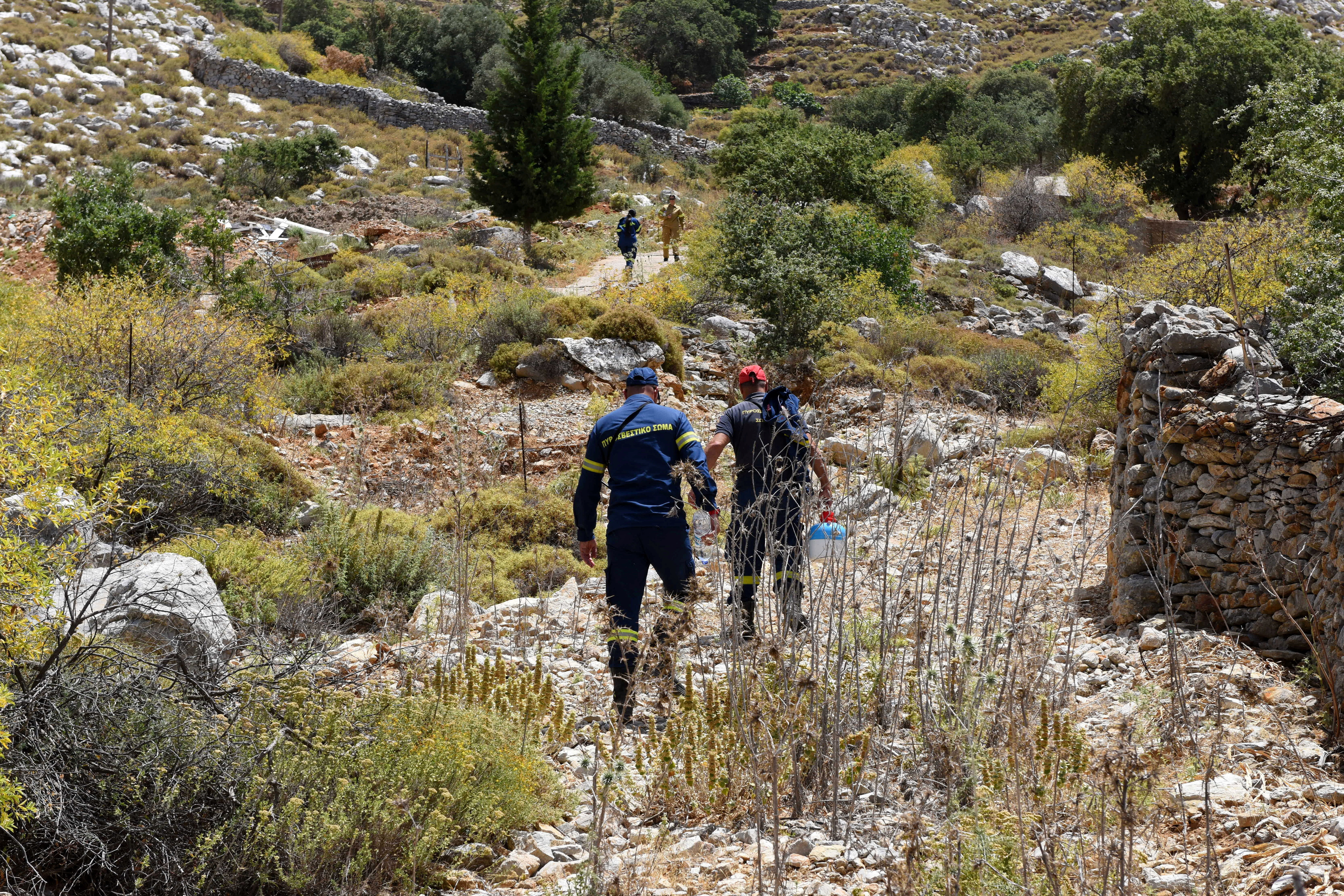
Sign up here.
Editing by Edward McAllister, Kevin Liffey, Christina Fincher and Timothy Heritage
Our Standards: The Thomson Reuters Trust Principles. New Tab , opens new tab
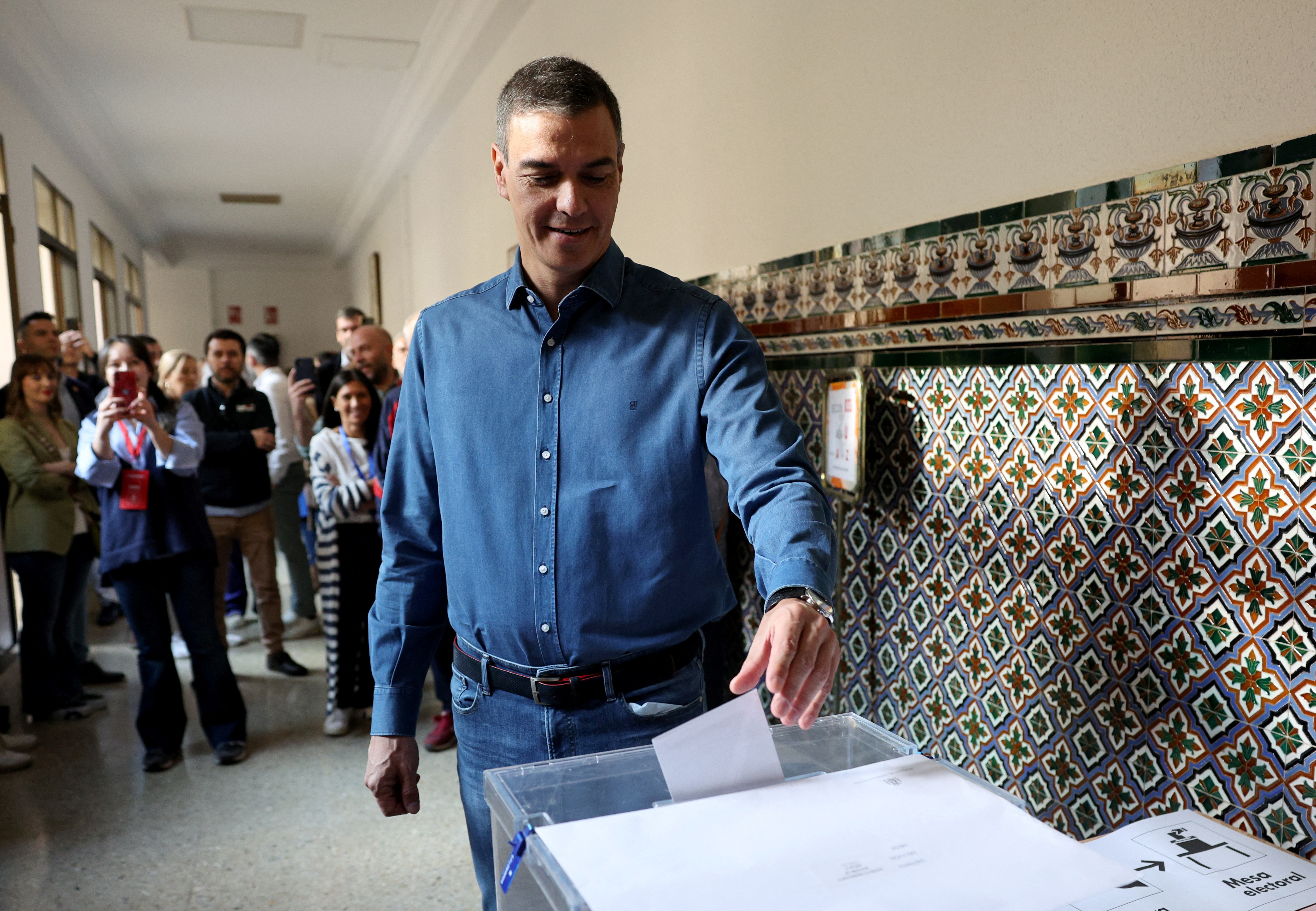
World Chevron
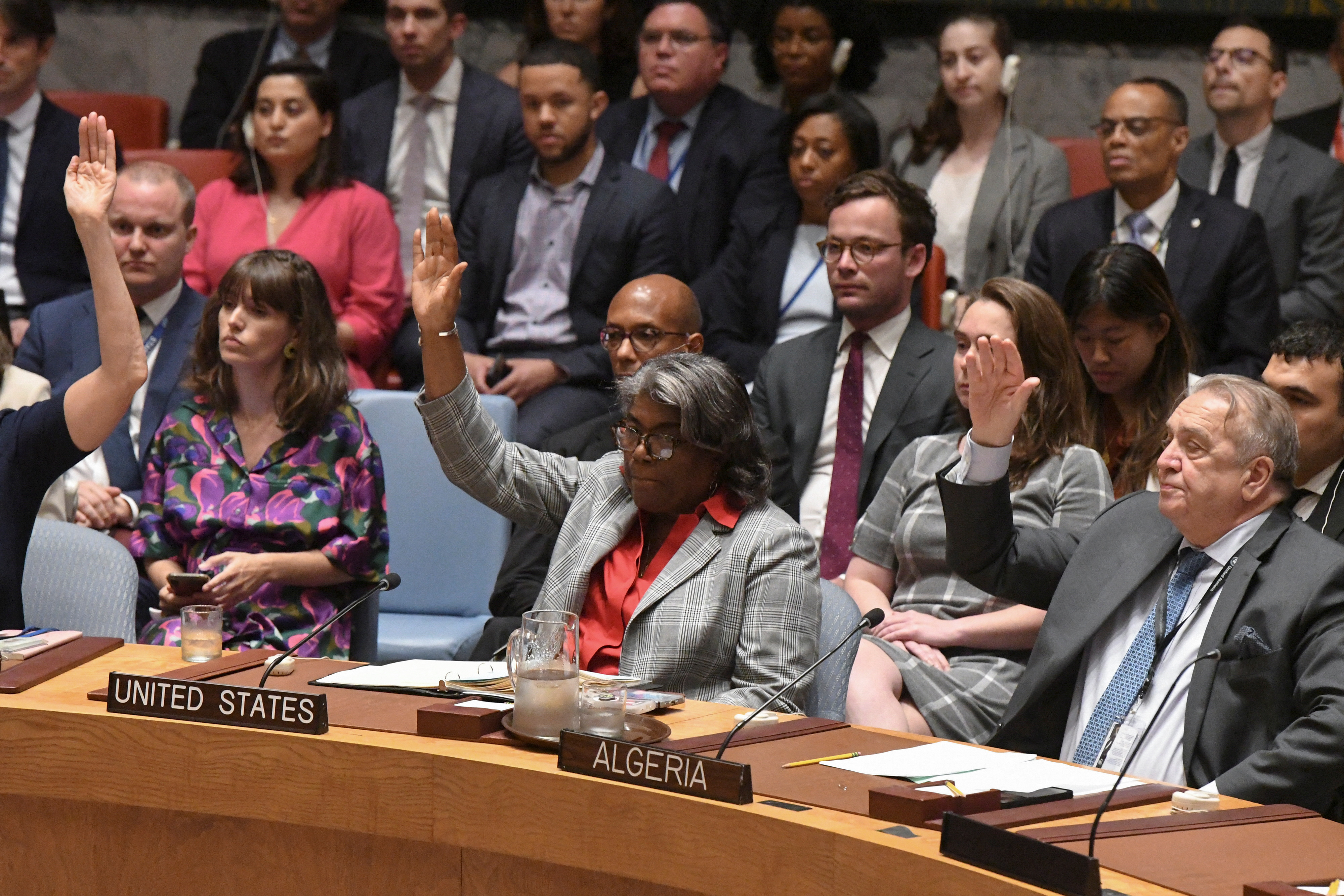
UN Security Council backs Israel-Hamas ceasefire plan
The United Nations Security Council on Monday backed a proposal outlined by President Joe Biden for a ceasefire between Israel and Hamas in the Gaza Strip and urged the Palestinian militants to accept the deal aimed at ending the eight-month-long war.
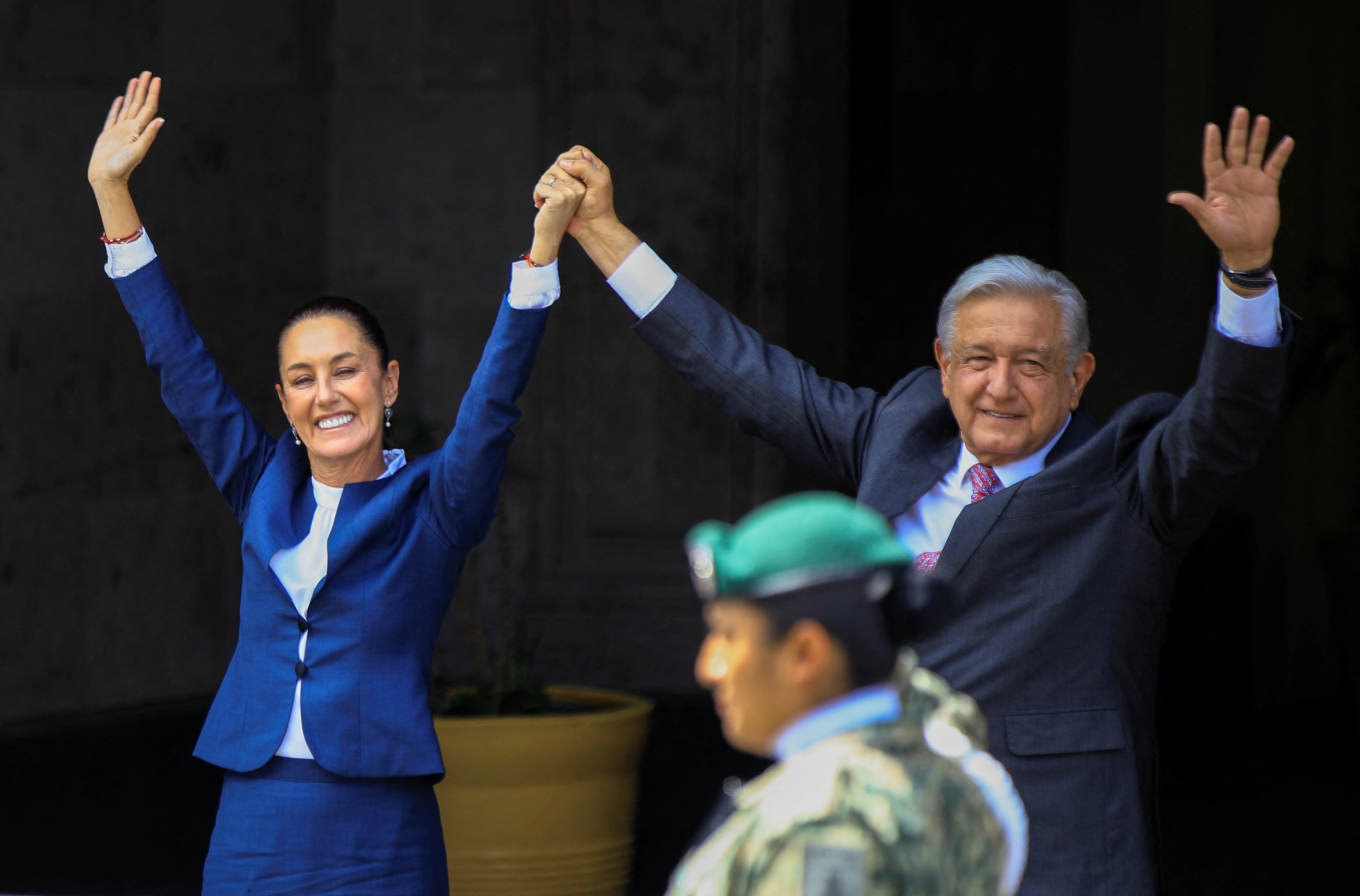

IMAGES
COMMENTS
Iconic Tourism Products. Vanuatu is a hidden, untouched paradise often unfamiliar to even the most seasoned travelers, yet the treasures it offers are iconic: rugged island landscapes, pristine beaches, beautiful coral reefs, awe-inspiring volcanoes that rise dramatically from island interior and one of the richest living diversity of cultural traditions anywhere in the world, with over 120 ...
Official Vanuatu tourism website by Vanuatu Tourism Office. Holiday info on resorts hotels tours travel packages adventure volcano scuba diving fishing hiking e
When visiting Vanuatu, you can buy "All things Vanuatu" from arts and handicrafts, fashion, island attires, painting, health and beauty products, herbs, spices, tanna coffee to much more. These treasures can make beautiful authentic gifts for friends and families plus when you buy products made in Vanuatu, you are supporting the local community ...
Your travel information and guide to Vanuatu islands by the Vanuatu Tourism Office. ... VTO has discovered a host of new products, helped develop them, and promoted them to domestic tourism consumers. Many local tourism consumers have created special memories of places and experiences.
The Vanuatu Tourism Market Development Plan 2030 is the VTO's sector strategy. It is currently under review following the COVID-19 pandemic. The plan will advocate for a continued ... improving the range of sustainable tourism products and services throughout Vanuatu. It does
Vanuatu Tourism Gets a Reboot. Naluandance, Malekula culture. All photos Courtesy of the Vanuatu Department of Tourism. The pandemic has caused massive disruption to the tourism industry around the world. But it has also created an opportunity for destinations to reboot the sector to move forward in a more thoughtful and sustainable way.
Tourism and economic diversification in Vanuatu. Vanuatu's formal economy is dominated by the tourism industry. Tourism is estimated to contribute 65 percent of Vanuatu's Gross Domestic Product, directly and indirectly, with the growth of tourism supported by Vanuatu's second most important contributor to the formal sector, construction.
Vanuatu, an idyllic paradise in the South Pacific, is enchanting the global market with its exquisite range of products that showcase the essence of this stunning island nation.
November 23, 2017. Mahitahi Handikraf Senta on the sea front is accepting vendors to fill 53 stalls in the newly built cool, breeze-filled, open thatch-roofed house that will open on November 29.. The criterion for all vendors is to strive to eventually sell only 'Made in Vanuatu' products in the new handicraft house. National Handicraft ...
Prospects for the post-pandemic tourism and economic recovery in Vanuatu. In many small island developing States (SIDS), tourism is the engine of economic growth, export earnings and formal employment. The COVID-19 pandemic ravaged global tourism, through a major slowdown of international tourism arrivals, billions of dollars of lost revenues ...
International travelers and tourism sector revenues from 1995-2020 in Vanuatu, including comparison with other countries in Melanesia
Tourism is estimated to contribute 65 percent of Vanuatu's Gross Domestic Product, directly and indirectly, with the growth of tourism supported by Vanuatu's second most important contributor to the formal sector, construction. Together, tourism and construction activity have driven economic growth in Vanuatu over the last decade.
Goal 3: Sustainable and responsible tourism products and services developed, supported, and marketed to attract responsible high-value tourists. Goal 5: Sustainable and responsible tourism brings improved income and well-being for Vanuatu and its people. 2.4.1 Develop music performance spaces for local artists.
This chapter recounts and examines the events triggered by the COVID-19 pandemic that produced a steep decline in Vanuatu's tourism industry, the key economic sector during the preceding three decades.
The products are authentically made locally with passion and generations of practice and from rich, nutritious recourses. Every product with the Vanuatu Made symbol supports our local people and their businesses - improving their lives and community.
TRAVELLING SAFELY IN VANUATU. The Vanuatu Government and the Vanuatu Tourism Office have been working with the tourism industry throughout the country to ensure the safety of the People of Vanuatu and travelers once borders can safely reopen. We have introduced the Safe Business Operations (SBO) initiative.
Sharing the Riches of Tourism in Vanuatu
This chapter focuses on Vanuatu's experience in terms of impacts to tourism businesses, a new domestic tourism campaign and public-private policy shifts to support the resilience of an industry in crisis. It presents three cases that illustrate the response and recovery efforts at the business, sector and policy levels.
We support tourism in Vanuatu via a range of skills development activities focusing on product development, sustainable business practices, & market access.
Tourism is critical to Vanuatu's economic prosperity. The Vanuatu Skills Partnership has worked closely with tourism authorities, including the Vanuatu Tourism Office (VTO) ... Improved accessibility of tourism products results in an increase in the number of visitors with disabilities, which contributes to business income. Following a visit ...
This infographic shows the share of European hoteliers who believe that domestic visitors are (very) important to the success of their business.
A new report, The promise of travel in the age of AI, produced by McKinsey and Skift Research offers use cases and success stories that detail how technologies are being used, drawing from interviews with executives at 17 companies across five types of travel business. It explores how companies apply advanced data science to better understand ...
Russian tourist Serguei Boyaryshnic wandered in awe among the pastel-colored buildings and cobblestone streets of Old Havana on a weekday morning, his family in tow.
Portugal's government vowed on Thursday to speed investments worth 366 million euros ($397.7 million) to combat a "systemic drought" in the tourism-dependent southern region of Algarve and quickly ...
Vanuatu Souvenir specialize in Vanuatu gifts and classic souvenirs! With 3 retail stores across Port Vila (Downtown, Central Bay Mall and Central) with a vast selection of Vanuatu gift ideas, it's a sure bet that you will find the perfect souvenirs to take home or send overseas. Discover our Vanuatu made tam-tams (a slit-drum instrument) tea ...
Vanuatu International Visitor Surveys. Below is a collection of reports produced using information collected from International Visitor Surveys.
A Dutch tourist has defaced a frescoed wall in an ancient Roman house in Herculaneum, near Naples, damaging a building that survived the volcanic eruption of Mount Vesuvius in 79 AD, Italian ...
The Economic Update 2024 report offers a comprehensive analysis of the state of the Cabo Verdean economy in 2023 and projections for 2024, providing valuable insights for policies aimed at strengthening the country's economy.
British TV presenter Michael Mosley was still missing on the mountainous Greek island of Symi as night fell on Friday, two days after he disappeared, but security camera footage potentially ...